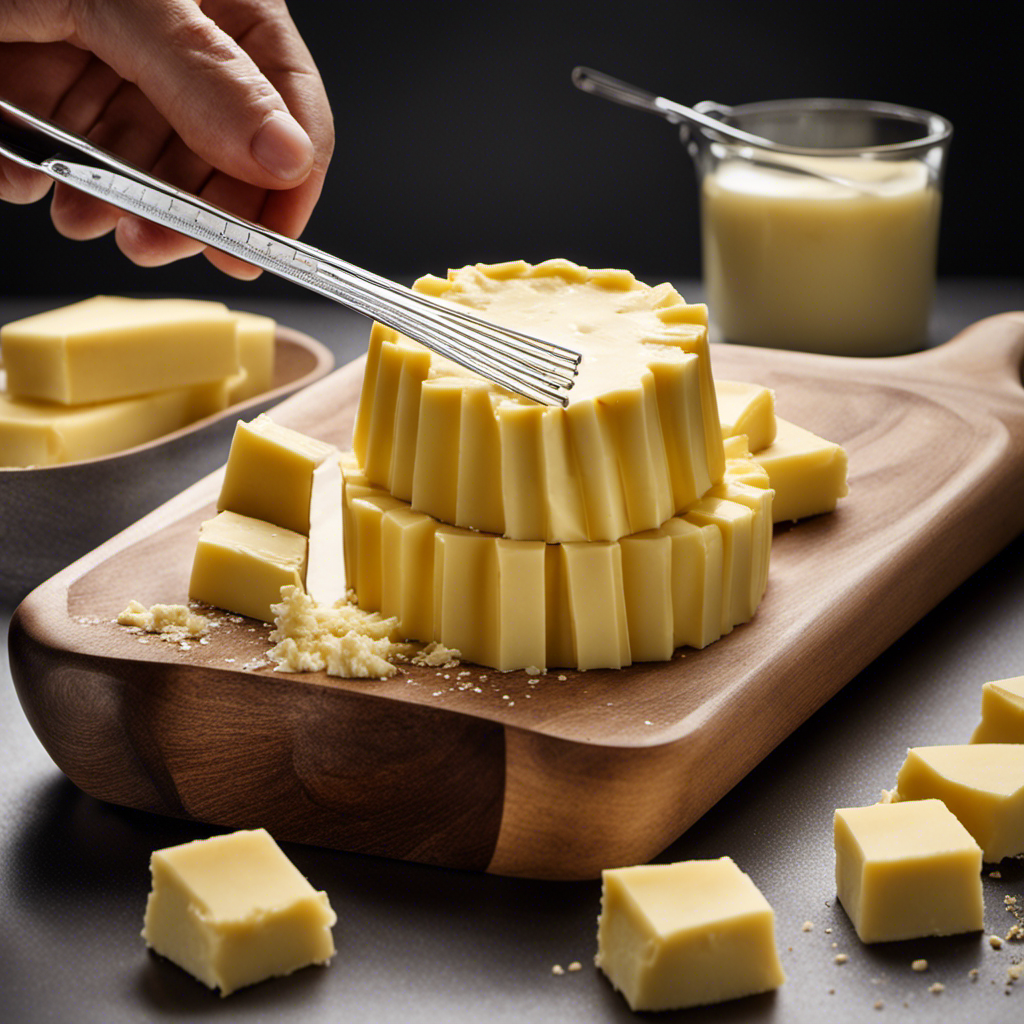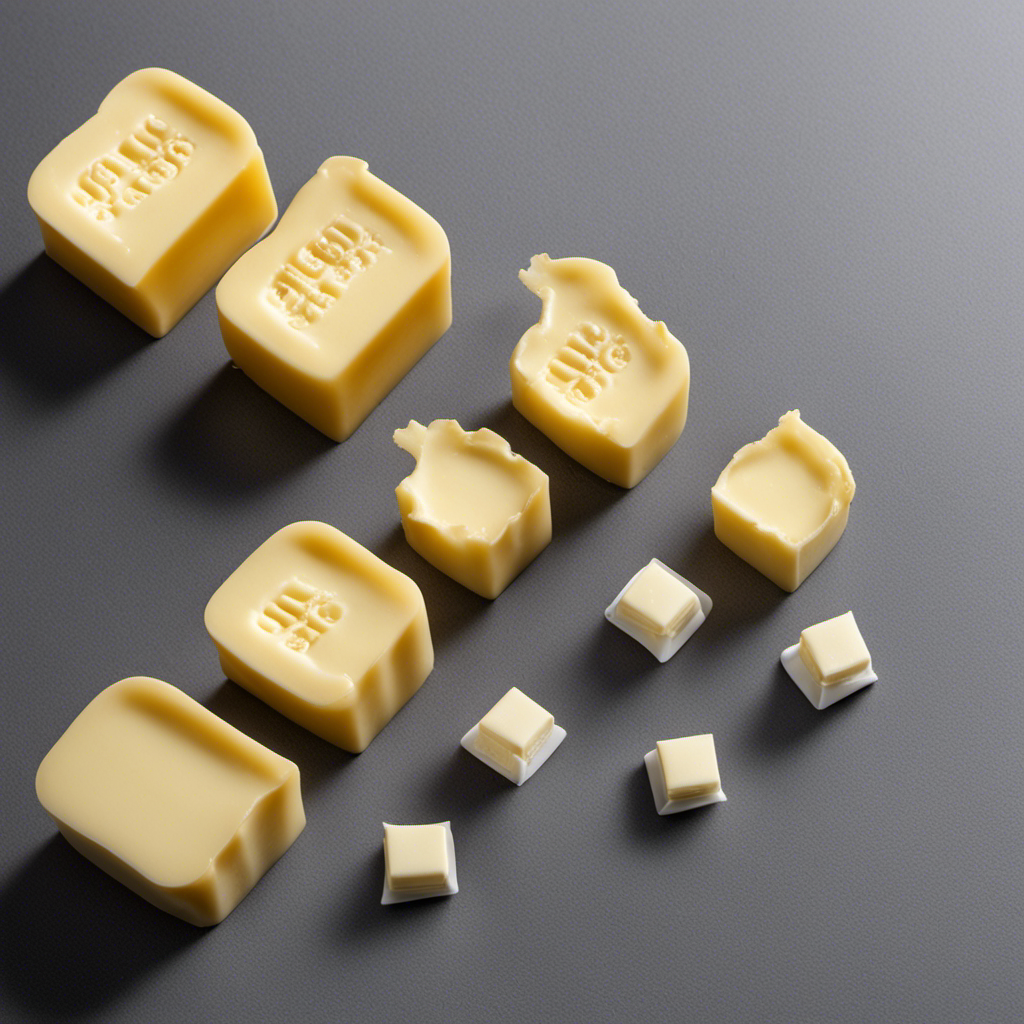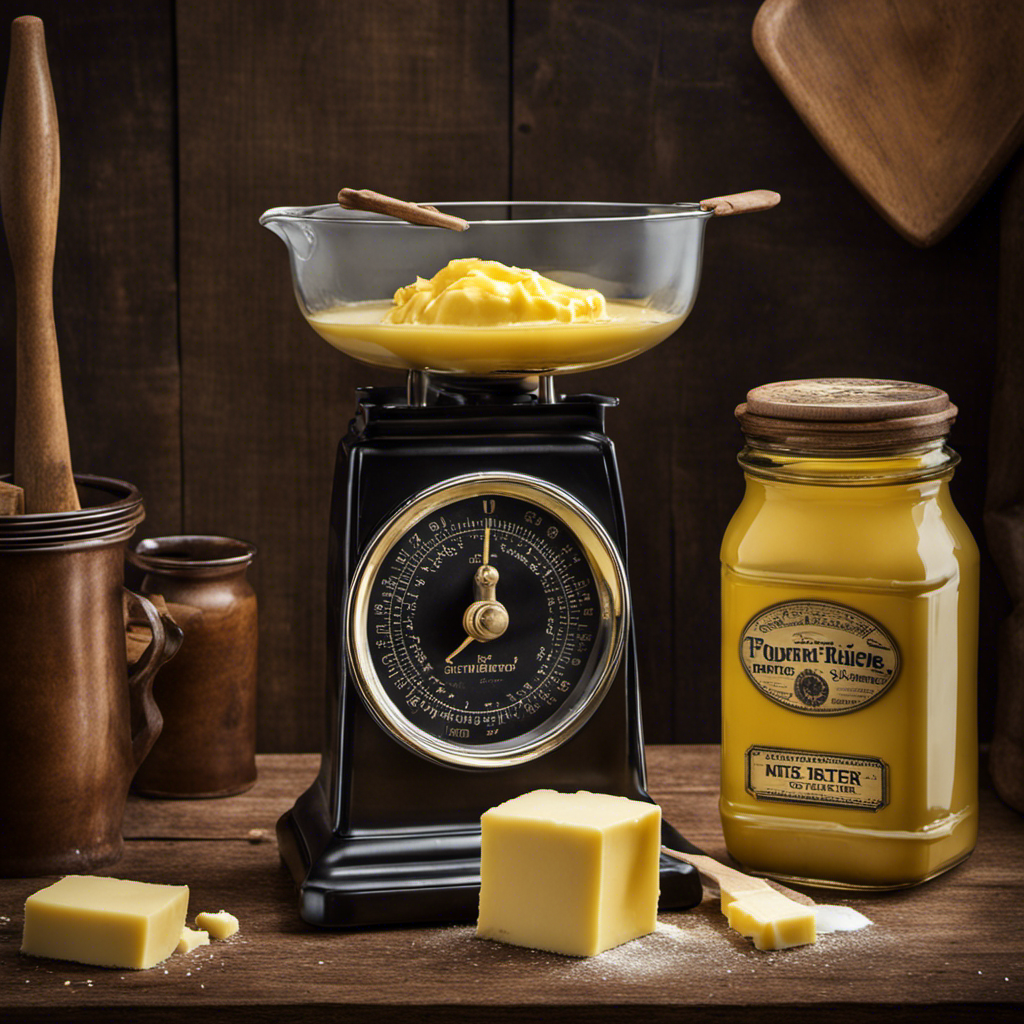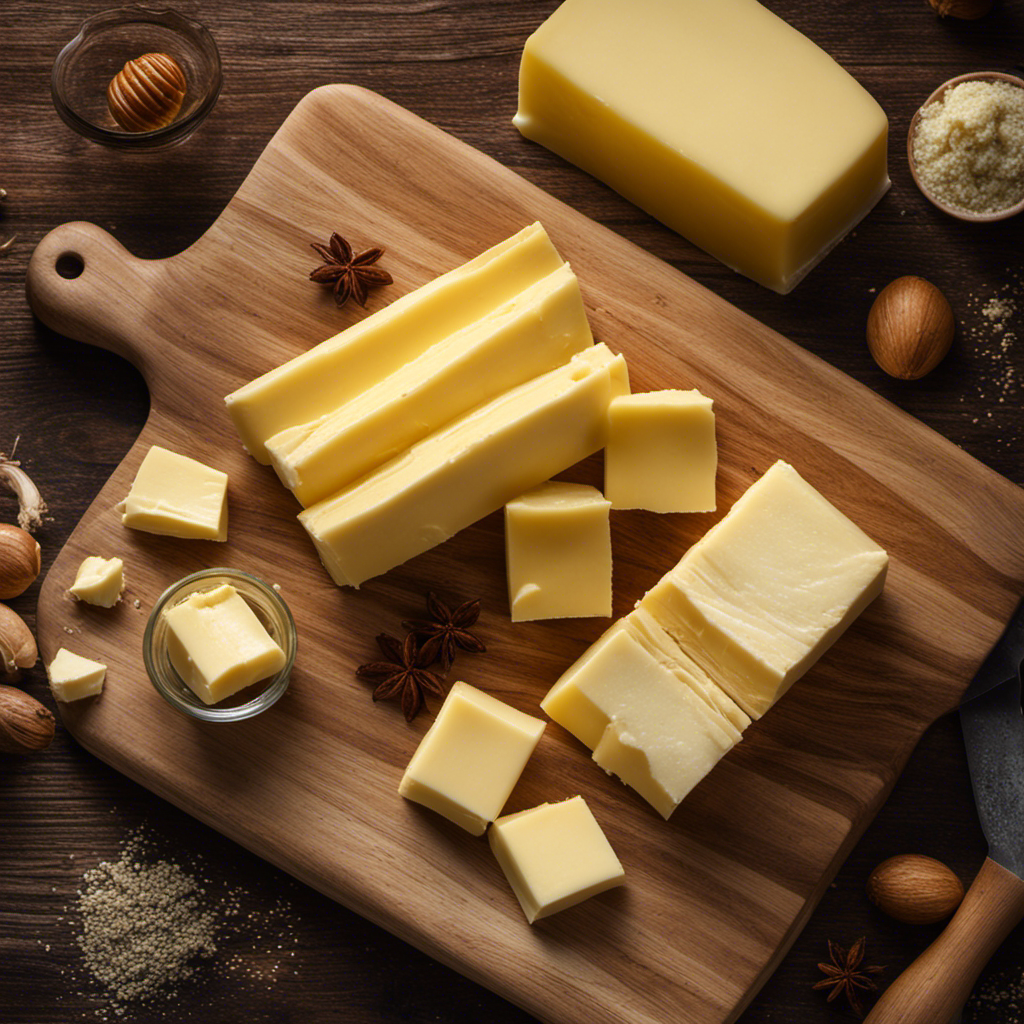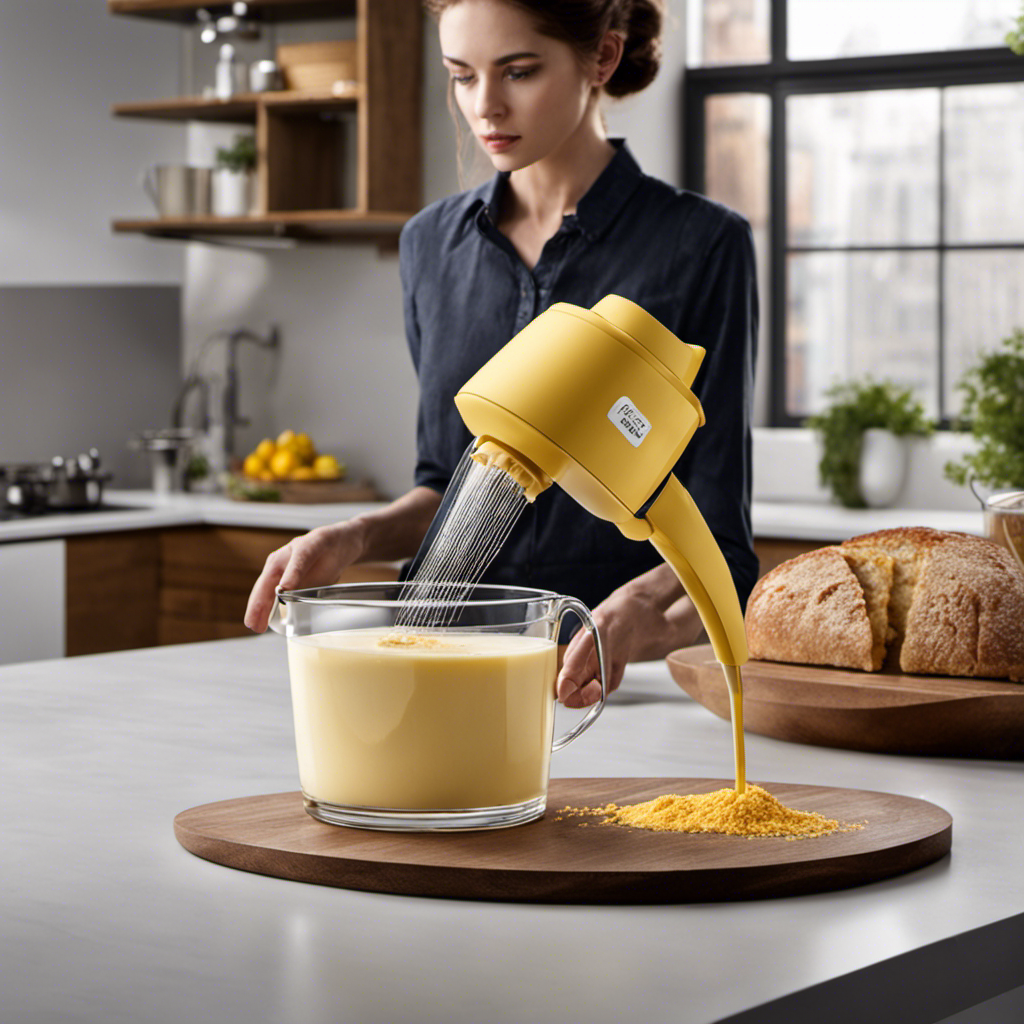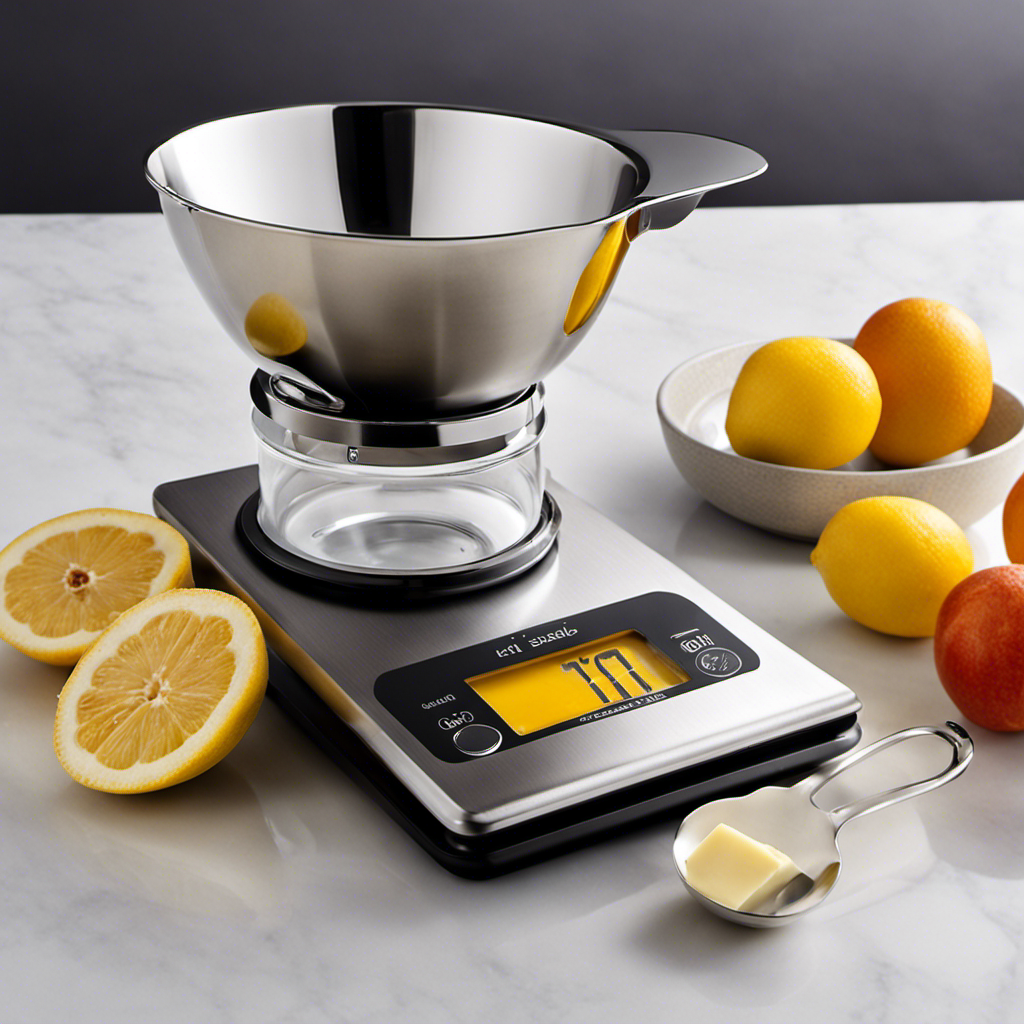Did you realize that 3/4 cups of butter is equivalent to 1 and a half sticks?
As a seasoned food expert, I understand the importance of accurate measurements in cooking and baking.
In this article, I will guide you through the process of converting cups to sticks, provide a helpful butter conversion chart, and share tips for mastering recipes that call for 3/4 cups of butter.
Whether you’re a novice in the kitchen or a culinary enthusiast, this article will ensure your butter measurements are spot on every time.
Key Takeaways
- 3/4 cups of butter is equivalent to 1 and a half sticks of butter.
- Accurate measurements are crucial in baking to ensure successful outcomes.
- Stick measurements provide accuracy, consistency, and convenience in recipes.
- Understanding butter measurements and conversions is essential for confident recipe following.
The Importance of Accurate Measurements
Accurate measurements are crucial when baking, as using the wrong amount of ingredients can drastically affect the final outcome of your recipe. When it comes to baking, precision is key. The importance of precise measurements cannot be overstated.
Whether it’s flour, sugar, or baking powder, each ingredient plays a vital role in the chemistry of your baked goods. Using too much or too little of any ingredient can throw off the balance and result in a less-than-perfect outcome. For example, adding too much baking powder can cause your cake to rise too quickly and then collapse in the center. On the other hand, using too little can leave your baked goods flat and dense.
Understanding the impact of inaccurate measurements on baking results is essential for achieving delicious and successful treats.
Now that we understand the significance of precise measurements, let’s dive into the next important aspect of baking: understanding butter measurements.
Understanding Butter Measurements
There’s no way to know how to measure butter without understanding the conversion between cups and sticks. As a culinary expert, I can provide accurate measuring techniques and alternative butter measurements to make your baking endeavors a success.
Here’s what you need to know:
-
One stick of butter is equal to 1/2 cup or 8 tablespoons.
-
If a recipe calls for 1 cup of butter, you’ll need 2 sticks or 16 tablespoons.
-
To measure butter without sticks, you can use a kitchen scale. One stick typically weighs 113 grams or 4 ounces.
-
Another alternative is to use a measuring cup with markings for tablespoons. Each tablespoon equals 1/8 of a stick.
Understanding these conversions allows you to confidently follow recipes and create delicious treats.
Now, let’s delve into a quick guide on converting cups to sticks for even more accurate measurements and baking success.
Converting Cups to Sticks: A Quick Guide
When it comes to baking and cooking, understanding the conversion ratio for butter is essential. Knowing how many sticks of butter are equivalent to a certain amount in cups can make a significant difference in the outcome of your recipe.
Whether you’re making cookies, cakes, or pastries, many common recipes rely on stick measurements for accuracy and consistency. Not only does using sticks of butter make it easier to measure, but it also provides a more precise result, ensuring that your baked goods turn out just right.
Conversion Ratio for Butter
The conversion ratio for butter is 1 cup equals 2 sticks. When it comes to butter, it’s important to know the equivalents for different measurements.
Here are some handy butter stick equivalents and butter measurement substitutions to keep in mind:
-
1 cup of butter is equal to 2 sticks. This is the most common conversion you’ll come across in recipes.
-
1 stick of butter is equivalent to 8 tablespoons or 1/2 cup. This is useful when you need to measure a smaller amount of butter.
-
If you don’t have sticks of butter on hand, you can use a butter block. 1 stick of butter is equal to 1/4 pound or 113 grams.
-
For those who prefer using weight measurements, 1 cup of butter weighs approximately 227 grams.
Knowing these butter conversions will help you navigate recipes with ease and achieve the perfect result. So the next time you’re in the kitchen, you can confidently measure out the right amount of butter for your culinary creations.
Common Recipes Using Sticks
Some common recipes using sticks of butter include chocolate chip cookies, brownies, and buttercream frosting. Butter is a versatile ingredient that adds richness and flavor to baked goods and frostings. In baking, butter is often creamed with sugar to create a light and fluffy texture. It helps cookies spread and gives brownies a tender crumb.
Buttercream frosting, made with butter, powdered sugar, and flavorings, is a classic topping for cakes and cupcakes. But did you know that there are also creative uses for butter sticks beyond baking? You can use softened butter to sauté vegetables, spread it on toast, or make a compound butter by mixing in herbs and spices.
The history of using butter in recipes dates back centuries, with butter being a staple in many cuisines around the world. Its creamy texture and rich flavor have made it a beloved ingredient in both sweet and savory dishes.
Benefits of Stick Measurements
You can easily measure stick quantities by using the markings on the wrapper. Stick measurements offer several benefits, simplifying conversions and making baking easier. Here are four reasons why stick measurements are a valuable tool in the kitchen:
-
Accuracy: Sticks of butter are pre-measured, ensuring precise amounts in recipes. This eliminates the need for guesswork or using a scale to weigh butter.
-
Convenience: Sticks are individually wrapped, making them easy to store and use. You can simply unwrap the required amount and add it to your recipe without the hassle of measuring cups.
-
Consistency: Stick measurements provide consistent results, especially when baking. This ensures that your cakes, cookies, and pastries turn out perfectly every time.
-
Time-saving: Stick measurements save time by eliminating the need to soften butter. You can easily cut the required amount directly from the stick, saving you precious minutes in the kitchen.
Stick measurements simplify the process of measuring butter, making baking more efficient and enjoyable. So next time you’re in the kitchen, reach for those trusty sticks and let them do the measuring for you.
The Ratio: How Many Sticks in a Cup of Butter
When it comes to baking, precise measurements are crucial for achieving the perfect texture and flavor. One common question that often arises is how to convert butter from cups to sticks.
Understanding the cup to stick ratio can simplify the process, allowing you to confidently follow any recipe without the need for complicated calculations.
In this discussion, we will explore the butter stick conversion, the cup to stick ratio, and provide tips for simplifying butter measurements in your culinary adventures.
Butter Stick Conversion
There’s no need to worry about converting cups of butter to sticks because one stick of butter is equal to half a cup. However, if you find yourself without a stick of butter and need to measure it in cups, here are some alternatives:
- Use a measuring cup: Fill the cup with butter until it reaches the desired measurement.
- Use a kitchen scale: Weigh the butter to determine the equivalent amount in cups.
- Use a butter dish: Some butter dishes come with measurements on the side, making it easy to scoop out the desired amount.
- Use a tablespoon: Since there are 16 tablespoons in a cup, you can measure out the butter using tablespoons.
Converting butter measurements may seem daunting, but with these alternatives, you can easily adapt any recipe to your preferred measurement method.
Whether you’re baking or cooking, knowing how to convert butter measurements ensures accuracy and consistency in your dishes.
Cup to Stick Ratio
The ratio of cups to sticks in butter is helpful to know for accurate and consistent measurements. As a culinary writer, I understand the importance of precise measurements in baking and cooking.
When a recipe calls for a certain amount of butter in cups, it’s essential to know how many sticks you’ll need. The standard ratio is that one stick of butter is equivalent to 1/2 cup. So, if a recipe requires 1 cup of butter, you’ll need two sticks.
However, it’s worth noting that alternative measurements for butter exist. Some recipes may call for tablespoons or grams instead of cups or sticks. Knowing the cup to stick conversion allows you to adapt recipes accordingly and achieve the desired results.
Simplifying Butter Measurements
To simplify your measurements, you can easily convert between cups and sticks of butter. Here are four essential tips for simplifying butter measurements:
-
Know the cup to stick ratio: One cup of butter is equal to two sticks or 16 tablespoons. This ratio is important to remember when you come across recipes that call for butter in cups.
-
Properly measure butter: When measuring butter in cups, be sure to pack it firmly into the measuring cup. Use a knife to level off the top for accuracy.
-
Avoid common mistakes: One common mistake is using the wrong measuring tool. Remember, cups and sticks are not interchangeable. Use the appropriate measurement for the recipe.
-
Use a handy butter conversion chart: Keep a conversion chart on hand for quick and easy reference. This will save you time and ensure accurate measurements.
Handy Butter Conversion Chart
You can easily find a handy butter conversion chart online to determine how many sticks are in a certain number of cups. When it comes to butter substitution or using alternative measurements, having a reliable conversion chart is essential in the kitchen.
As a food expert, I understand the importance of accuracy and precision when it comes to baking and cooking. A butter conversion chart provides a simple and convenient way to transform measurements from cups to sticks, ensuring that your recipes turn out just right.
Baking Tips for Perfect Butter Measurements
When it comes to baking, getting the perfect measurement of butter is crucial for achieving the desired texture and flavor in your baked goods. However, not everyone has a kitchen scale or measuring cups on hand. Don’t worry, there are alternatives to measuring butter accurately.
-
Use the markings on the butter wrapper: Most butter packages come with markings indicating tablespoons, which can be helpful for measuring smaller amounts of butter.
-
Use a kitchen scale: If you have a kitchen scale, you can weigh the butter directly. This method ensures the most accurate measurement.
-
Use a butter dish with measurements: Some butter dishes have measurements marked on the side, allowing you to easily measure the amount of butter needed for your recipe.
-
Troubleshooting butter measurements: If your recipe calls for melted butter but you only have cold butter, a general rule of thumb is to use 1 1/4 cups of cold butter for every 1 cup of melted butter required.
Mastering Recipes With 3/4 Cups of Butter
Mastering recipes with 3/4 cups of butter can elevate your baking skills and create delicious treats. Butter is a key ingredient in many desserts, providing moisture, richness, and flavor.
However, there are alternative ingredients that can be used in recipes if you prefer to avoid or reduce the amount of butter. One option is to substitute with coconut oil, which has a similar texture and taste.
Another alternative is using Greek yogurt or applesauce, which can add moisture while reducing the fat content. These substitutions can work well in various butter-based desserts, such as cookies, cakes, and bars.
Experimenting with different ingredients can offer unique flavors and textures to your baked goods, allowing you to create delicious treats while catering to different dietary preferences.
Common Mistakes and How to Avoid Them
Using alternative ingredients in your recipes can help you avoid common mistakes and create delicious baked goods. Here are some tips to ensure accurate measurements and find butter equivalents:
-
Use a kitchen scale: Measuring ingredients by weight provides the most precise and consistent results, especially for butter. One stick of butter weighs 113 grams or 4 ounces.
-
Substitute with oil: If you’re looking for a healthier option or simply ran out of butter, you can use oil instead. Use 3/4 cup of oil for every 1 cup of butter called for in the recipe.
-
Try margarine or vegan butter: For those avoiding dairy, margarine or vegan butter can be used as a 1:1 substitute for butter. Make sure to choose a high-quality brand to achieve a similar taste and texture.
-
Experiment with nut butters: Nut butters like almond or cashew butter can add a unique flavor to your baked goods. Use 3/4 cup of nut butter for every 1 cup of butter in the recipe, and adjust the other ingredients accordingly.
Frequently Asked Questions
How Do I Convert Tablespoons of Butter to Sticks?
To convert tablespoons of butter to sticks, you can refer to a butter conversion chart. It will provide accurate measurements for various amounts of butter. It’s a helpful tool for precise baking and cooking.
Can I Substitute Margarine for Butter in a Recipe That Calls for 3/4 Cups of Butter?
Substituting margarine for butter in a recipe is possible, but it may affect the taste and texture. Margarine contains more water, so adjust accordingly. There are also alternatives to butter like coconut oil or applesauce for a healthier option.
What Is the Weight of 3/4 Cups of Butter in Grams?
3/4 cups of butter is equivalent to 1 1/2 sticks. When it comes to the weight measurement, 1 stick of butter typically weighs 1/2 cup or 113 grams. Therefore, 3/4 cups of butter would weigh around 170 grams.
How Many Ounces Are in 3/4 Cups of Butter?
To accurately measure 3/4 cups of butter, consult a conversion chart for different measurements of butter. It’s important to know how many sticks are needed in order to achieve the perfect consistency in your recipe.
Is It Necessary to Use Unsalted Butter When Measuring 3/4 Cups for Baking?
Using unsalted butter in baking recipes is important for controlling the amount of salt in the dish. To measure accurately, soften the butter and pack it into a measuring cup, adjusting as needed.
Conclusion
In conclusion, understanding accurate measurements in baking is crucial for achieving the perfect results. When it comes to butter, knowing how many sticks are in a specific measurement can make or break a recipe.
With 3/4 cups of butter, you’ll need 1 1/2 sticks. Remember, butter is the foundation of many delicious treats, so getting the measurements right is like finding the perfect balance of flavors in a dish.
So next time you’re baking, be sure to master the art of butter measurements for a truly delightful culinary experience.
